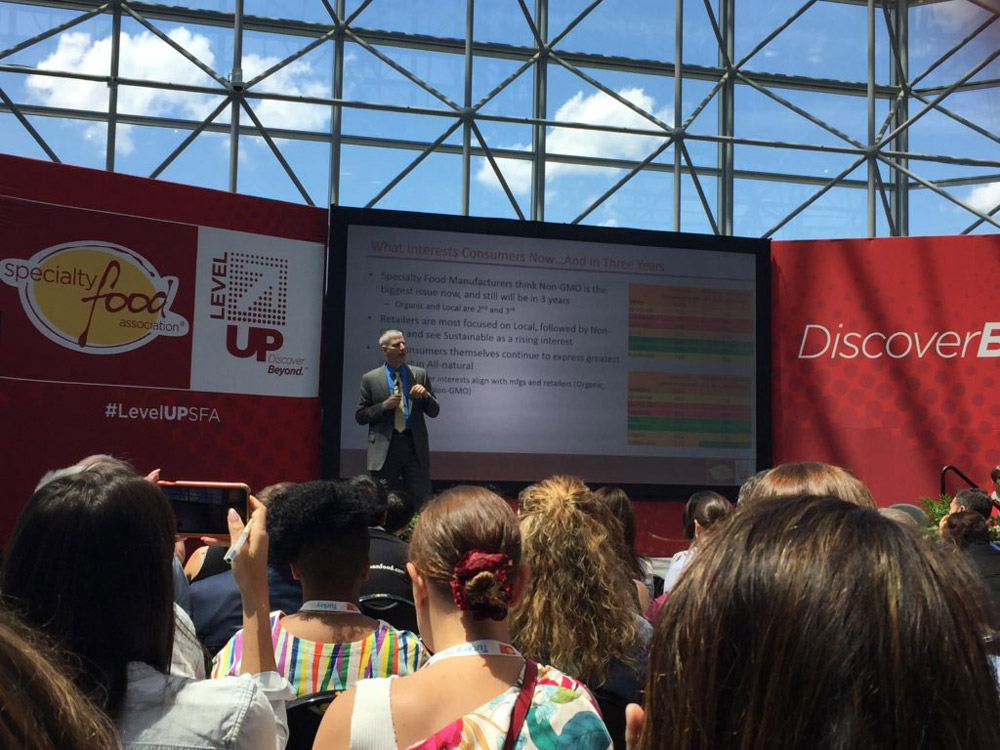Summer Fancy Food Show: Tastes and Trends You Should Know

It’s a wrap! I tasted the world at The 2017 Specialty Food Summer Show in New York City and was inspired by items I could have never imagined and intrigued by the trends and forecasts of this nearly $130 billion industry. The Specialty Food Association, a non-profit trade organization with a large community of food artisans, importers and entrepreneurs, just celebrated its 65th anniversary.
Whether you are a foodie or a food entrepreneur, it’s important to know what to expect in the specialty food market. Here are some highlights and insights:
- The Bounty of Brazil. As a graduate student who lived in Rio de Janeiro 30 years ago for an internship, I always appreciated that Brazil is a trendsetter. I remember the many fresh fruit stands that featured smoothies throughout Rio years before blending became popular in the United States. Sunbathing on Ipanema beach, I would drink coconut water straight from the coconut years before this became popular in the United States. And of course Brazil introduced us to acai. So what’s next from this wonderful country? Here are some items I am really excited to share:

- Pink Pepper. Get ready for this fabulous pink phenomenon. We already have pink Himalayan salt. Now there is pink pepper from Brazil! Grown on the Atlantic coast of Brazil, the peppercorns from this berry bush are being requested by many chefs around the world. According to Millar Agro Business, many chefs enjoy placing the pink peppercorns on top of ice cream.
- Tapioca Flour. Indigenous to Brazil, the cassava plant has a new product: Wrapioca, a gluten free bread that is made from water and cassava. Pour 1/4 cup of this non-GMO, gluten free and 100% natural product into a frying pan and cook over medium heat for 1 minute or until the edges unstick and then add your favorite filling (sweet or savory). I especially enjoyed a filling of Nutella.
- Cupuacu This flavorful fruit grown in the Amazon Forest is called “Pharmacy in a Fruit” by many Brazilians and is poised to become the next super fruit in the U.S. market. I sampled delicious Amazonia Cookies with cupuacu fruit at the show.
2) Tasty Trends: The Food Market of Tomorrow
With a business background and a Master’s degree in International Business, I especially enjoyed the addition of SFA Level Up presentations featuring the discussion of trends and forecasts in specialty food with David Lockwood of Mintel and Shelley Balanko of The Hartman Group.
- Growth Bites. For those of you with a sweet tooth, frozen desserts will be growing by 14% annually. Sparkling water will also experience impressive annual growth of 20%. Consumers continue to drive the demand for products that are non-GMO, all natural and sustainable. Shelley Balanko said, “Consumers are looking for food that is healthy and convenient.” Mark Hamstra writes that “Specialty food sales are projected to grow at a 7.7 percent compound annual growth rate during the next five years, driven by consumers’ interest in health and wellness, their desire for food ‘experiences’ and their demand for transparency.”
- The Digitized Palate. Melissa Abbott of The Hartman Group emphasized that “Diet personalization will drive consumers’ food choices, leading to increased customization of their specialty food buying and consumption.” According to a recent article posted on SFA website, an Acosta study shows that “28% of U.S. shoppers prefer to purchase groceries regularly online; however, 97% of all consumer packaged goods are still purchased in brick and mortar retail stores.”
- Plant-Based Power. According to Melissa Abbott of The Hartman Group, “From heirlooms to specialty produce to hybrids, consumers are discovering how complex, flavorful and seemingly limitless vegetable-centric dishes can be.” In an SFA publication article, Julie Gallagher notes that “plant-based ingredients will drive innovation.” She notes that in the Taste Tomorrow area, food incubators and universities displayed products under development spotlighting plants as sustainable food sources. Attendees had the opportunity to sample foraged products such as jerky made from local kelp and mushroom scraps.
3) The Bottom Line
- Seismic Disruptor. Of course Amazon’s recent acquisition of Whole Foods was a constant topic at this year’s Summer Fancy Food Show. David Lockwood and Shelley Balanko both see this as “a strategic distribution move.” Another interesting perspective from Lockwood about the acquisition is that “it could be a big move for Jeff Bezos, CEO of Amazon to do more on the charity front” given the community outreach that Whole Foods embraces. This pending acquisition creates some uncertainty regarding impact on pricing and traditional supply routes for specialty food sales; however, with change comes opportunity, and Specialty Food Association will be a great resource to keep the producers, suppliers and buyers updated.
- Specialty Food Industry Growth In the U.S. alone, specialty food sales account for nearly $130 billion and are forecast to grow annually at a 7.7 percent compound rate for the next five years. According to Phil Kafarakis, the new Specialty Food Association President, “Consumer preferences for specialty food products are growing at double digits, outpacing mainstream food staples. The products our members create appeal to consumers looking for authentic tastes and foods with fewer and cleaner ingredients.” During the Sofi Award ceremony for Best New Product, Kafarakis reiterated SFA’s commitment to its members, “These awards represent a premium component of how we at Specialty Food Association will bring promotion and champion, nurture and connect the community so specialty food is increasing its consumption and share of the marketplace.”
What new trends and products in the specialty food market interest you the most?
Savor the day!


